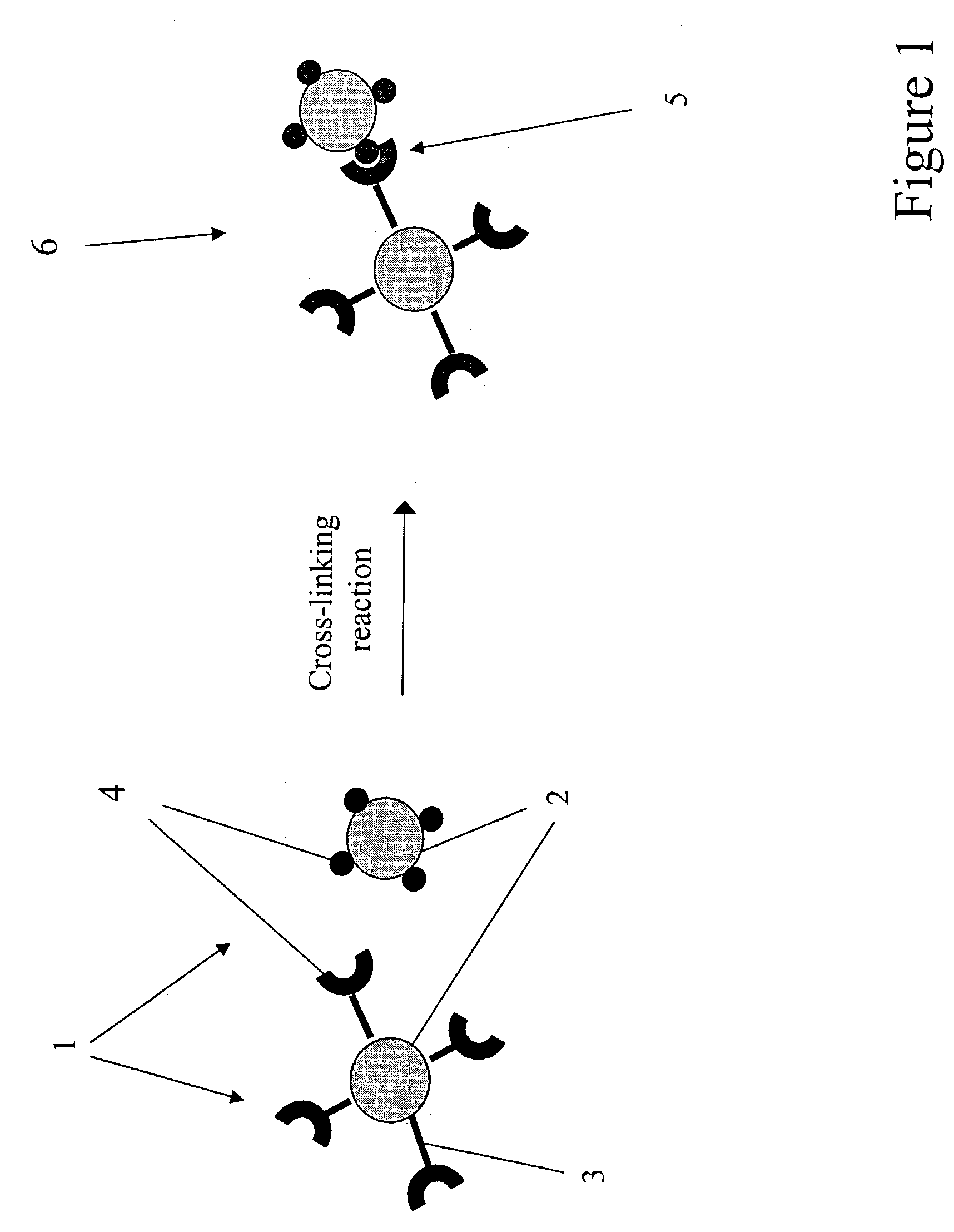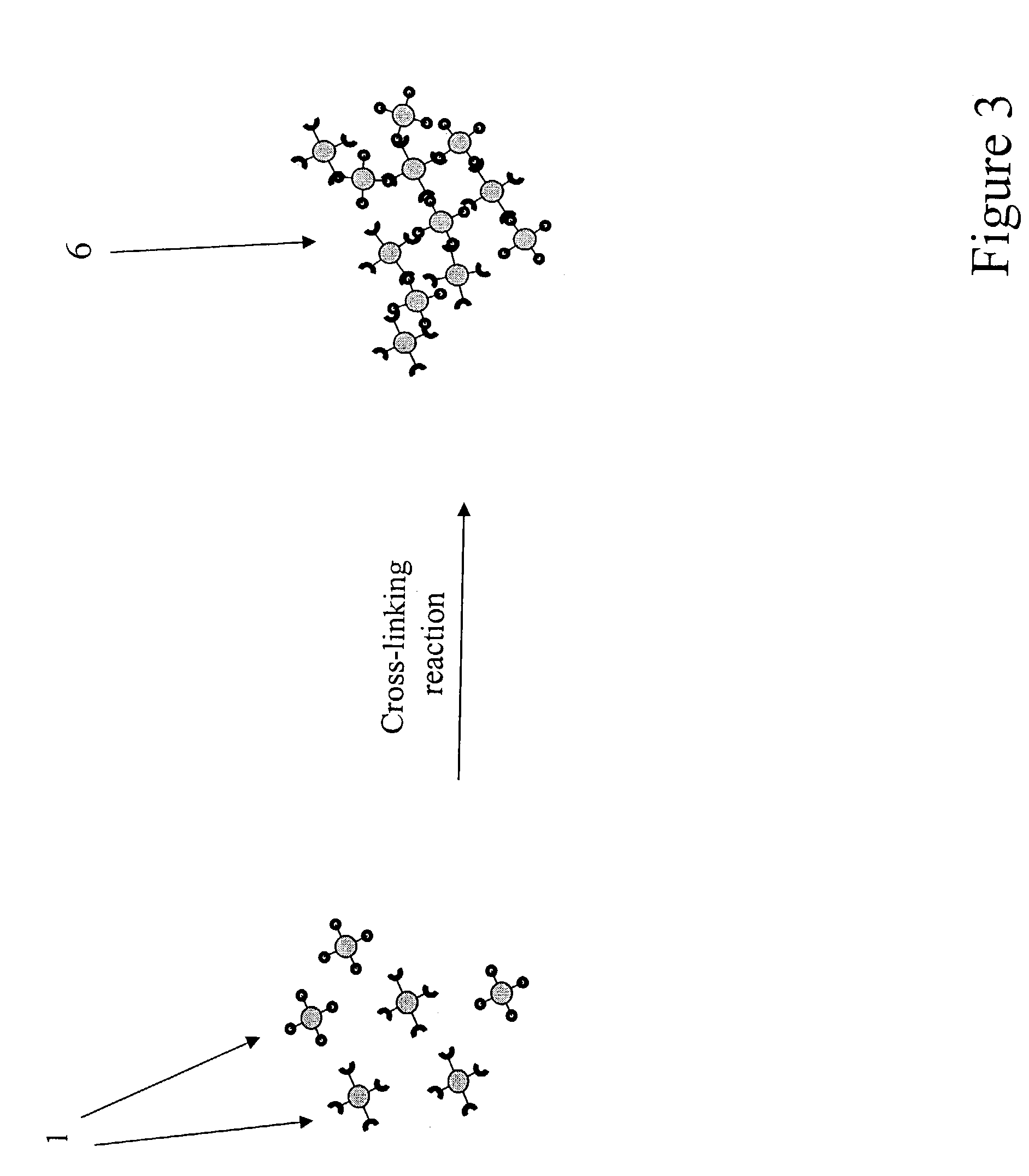Agglomerated particles for aerosol drug delivery
- Summary
- Abstract
- Description
- Claims
- Application Information
AI Technical Summary
Benefits of technology
Problems solved by technology
Method used
Image
Examples
example 1
Preparation of Liposomes
[0106]Two different types of liposomes were prepared. One type of liposome had, attached to its surface, polyethylene glycol (PEG) as a tether (MW=2000) with a —COOH group (i.e., reactive chemical group), attached to the end of the PEG molecule that was not attached to the liposome. The second type of liposome had, attached it its surface, PEG tethers with an —NH2 reactive chemical group attached to the end of the PEG molecule not attached to the liposome. To make these liposomes, a 10 ml solution containing 20 mM of total lipid was prepared. The breakdown of lipid in the solution was 40% cholesterol (30.9 mg, MW 386.7), 55% dipalmityl phosphatidyl choline (DPPC) (80.7 mg, MW 734) and 5% of either DPPE-PEG—COOH (dipalmityl phosphatidyl ethanolamine)(30.9 mg, MW 2741.46) conjugate or DPPE-PEG-NH2 conjugate (27.1 mg, MW 2713.46). The components were dissolved in 1 ml of ethanol and warmed to 49° C. Nine ml of MES buffer was also warmed to 49° C. The MES buffer ...
example 2
Making Liposome Agglomerates
[0108]Reactions were performed using the liposomes described in Example 1 above to crosslink the liposomes and form agglomerates. In one reaction, only NH2 liposomes were used. These liposomes were crosslinked to one another using sulfo-[ethylene glycobis(succinimidylsuccinate)], also called S-EGS. In one reaction, 0.2 ml of NH2 liposomes (approximately 6.7×1010 liposomes) and 2.2 mg of S-EGS were mixed in a total of 10 ml of phosphate buffer. In a second reaction, 0.3 ml of NH2 liposomes (approximately 1×1011 liposomes) and 3 mg of S-EGS were mixed in 10 ml of phosphate buffer. In a third reaction 0.3 ml of NH2 liposomes and 6 mg of S-EGS were mixed in 10 ml of phosphate buffer and reacted overnight at room temperature. For the agglomeration, a 50–150-fold molar excess of sulfo-EGS was used over the NH2 groups. The three sets of agglomerated liposomes were analyzed by Fraunhofer diffraction to determine the size distribution of the agglomerates. See FIG....
example 3
Encapsulation of Insulin by Liposomes and Formation of Agglomerates
[0111]A mixture was made by dissolving 10 mg (of insulin in 9 ml of 0.9% NaCl, pH 2.6. A separate mixture was made by dissolving DPPE-PEG-NH2 conjugate (MW 2713.46) in 1 ml of Ethanol to make a 20 mM solution. The two mixtures were heated separately in a water bath until the lipids were dried. The dried lipids were then hydrated by mixing with the insulin solution. The liposomes that were formed were extruded through a 0.2 micron membrane ten times. After extrusion, the pH was adjusted to 5.1 using HCl or NaOH in order to cause precipitation of both free as well as encapsulated insulin. The precipitated free insulin was separated from the liposomes by passing the suspension through a 0.8 μm filter causing the precipitate to be retained on the filter. Dialysis was then used to remove ethanol and remaining insulin in the external phase [Spectra / Por biotech cellulose ester membranes (100,000 Dalton MWCO) from Fisher Sci...
PUM
| Property | Measurement | Unit |
|---|---|---|
| Diameter | aaaaa | aaaaa |
| Diameter | aaaaa | aaaaa |
| Composition | aaaaa | aaaaa |
Abstract
Description
Claims
Application Information
 Login to View More
Login to View More - R&D
- Intellectual Property
- Life Sciences
- Materials
- Tech Scout
- Unparalleled Data Quality
- Higher Quality Content
- 60% Fewer Hallucinations
Browse by: Latest US Patents, China's latest patents, Technical Efficacy Thesaurus, Application Domain, Technology Topic, Popular Technical Reports.
© 2025 PatSnap. All rights reserved.Legal|Privacy policy|Modern Slavery Act Transparency Statement|Sitemap|About US| Contact US: help@patsnap.com



